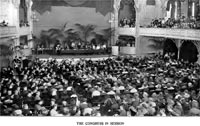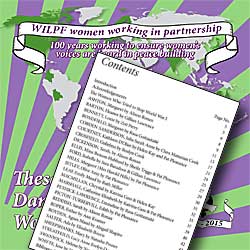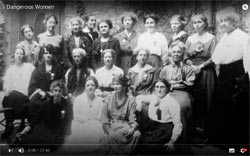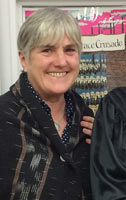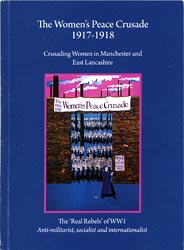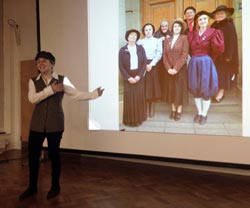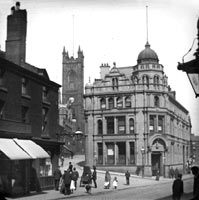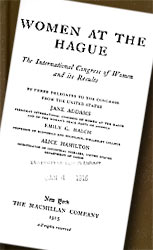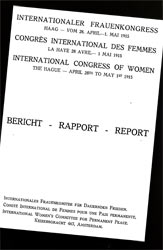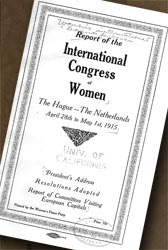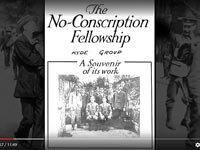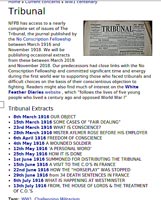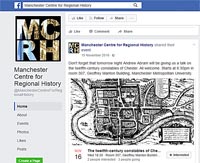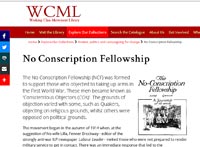
'THE GREAT WAR', 'THE WAR TO END WAR', 'WORLD WAR 1'
'What passing-bells for these who die as cattle?
- Only the monstrous anger of the guns.'
from 'Anthem for Doomed Youth'
by Wilfred Owen
1914 - 1918
CAMPAIGNING FOR PEACE With hindsight and a time lapse of 100 years we look back on the events of 1914 - 1918 with a different eye and emotions from those of the men and women caught up at the time. Broadly speaking, we can imagine that there were those who thought a war against the Central Powers (Germany, Austria and their allies) was the only answer and those that thought that Britain should not be involved in this war. However, there were still further differences splitting both the anti and pro-war stances. Nowhere did this seem more obvious than amongst women, and particularly those who were politically or socially active. There was a general desire for peace ... but not 'at any price'. Peace campaigners wanted a negotiated peace from which, basically, both sides of the conflict would emerge with their self respect and territorial rights intact. This was an unacceptable concept for the many who had sacrficed so much and for those who faced those who now faced those same sacrifices. Broadly speaking, their philosophy was that Germany and the Central Powers should be defeated by force and then punished economically and territorially. When War was declared, Mrs. Pankhurst and her daughter Christabel declared that the WSPU (the Women's Social & Political Union, ie., the Suffragettes) would suspend campaigning for women's suffrage and support recruitment for the armed forces. Many suffragettes disagreed and some, like Sylvia Pankhurst, devoted their energies to working on the 'Home Front' or abroad, supporting and caring for those in need of aid. The NUWSS (the non-militant Suffragists) were also split. There were those who believed that their efforts should be in supporting the government by working on the Home Front; taking the place of men in the workplace and freeing them for war; nursing and voluntary work in all sectors; raising money for hospitals, ambulances convalescents etc. . On the other hand there were those suffragists who believed that it was totally wrong to support the war in any way at all, including manufacturing armaments, aid work, or any work facillitating the war effort. They devoted their efforts to campaigning for a negotiated peace and, after the introduction of conscription in early 1916, in supporting conscientious objectors. As months and years passed, the divisions became more bitter and, when conscription was introduced in early 1916, opinions hardened. Prominent amongst the anti-war groups were the Quakers, the No-conscription Fellowship, the Independent Labour Party, the United Suffragists, The Women's International League and the Women's Peace Crusade. Rewind to early 1915 and women from around the world, many of whom had already met before the war, as members of the International Woman Suffrage Alliance (in order to discuss issues of suffrage and women's rights), decided to convene a meeting to discuss how Peace could be achieved without winners or losers; victors or vanquished. Neutral Netherlands was chosen and women around the world were invited to send delegates to a Congress, in The Hague, from the 28th April to the 1st May. In Britain, 180 women were selected as delegates but, when they applied for their passports, all but 24 were refused. The government granted passports only to those they considered 'sensible women'. On the appointed day they set off by train to catch a ferry from Tilbury but, when they arrived, Winston Churchill, as Minister of War, had given orders that the North Sea and the Channel, were to be closed to commercial shipping ... and the embargo remained in place for 2 weeks. The British delegates could not get to the Congress. Russian and French delegates were also refused permission, by their own governments, to attend. However, three British women did reach the Hague in time to attend the Congress. They were, Mrs. Pethwick Lawrence who had been in America and travelled with the American delegates, Katherine Courtney and Chrystal MacMillan who were already in the Netherlands organising the Congress.
The League met again in 1919 when their suggestions for inclusion in the terms of the Treaty, after the Central Powers surrendered, were rejected and the foundations of the Women's Interational League for Peace and Freedom were laid.
|
||||||||||||||
Read more about the Women's International League & Campaign for Peace in 1915 ... Below, Free Download of Books, as .pdf files, from the Internet Archive |
||
|
|
|
USEFUL LINKS TO OTHER WEBSITES |
||
|
Northern Friends (Quakers) |
||
Return
to WW1 Menu Page or to :

in the Conscientious Objection Pages
If you have Oldham and District items that we can include on our website, PLEASE visit the information page to find out how you can help.
